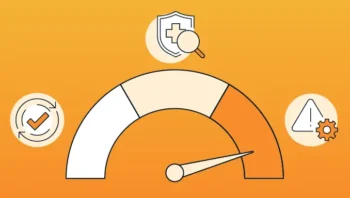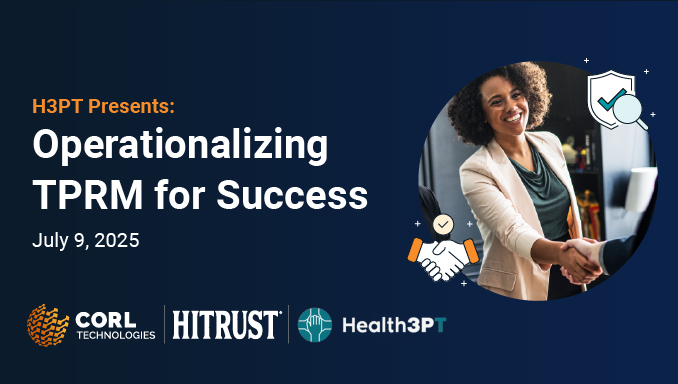
BlogTPRM
Top 10 Healthcare Supplier Risk Management Challenges Facing Providers in 2025
3 Minute Read
Read Top 10 Healthcare Supplier Risk Management Challenges Facing Providers in 2025TPRM
By CORL Technologies | November 30, 2021
Healthcare organizations have become increasingly dependent on third-party vendors in the supply chain to deliver mission-critical operational and support services. However, the volume and magnitude of cyber breaches of supply chain vendors has healthcare organizations struggling to stay ahead of the next vendor breach. Current models for issuing and reviewing vendor questionnaire assessments are not able to scale to keep pace with mounting vendor risk exposures.
Healthcare has moved a majority of our critical IT systems to third-party and cloud hosted vendors as part of the ongoing digitization of healthcare. However, the problem with this is that we have become dependent on these third-party vendors to deliver critical patient care, treatment, and operations.
When a vendor has an outage due to ransomware or some other cybersecurity breach, the healthcare organization feels the pain. And that pain is now much more than the threat of regulatory non-compliance with HIPAA due to lost or stolen data; the breaches are now impacting the ability for healthcare organizations to operate and are threatening patient safety.
Refer to the following resources for additional guidance on this topic of third-party risk management:
Cyberattacks on healthcare’s supply chain have been growing exponentially in the last several years. These attacks had introduced substantial social and political implications. In 2021 alone, the industry experienced massive supply chain breaches including SolarWinds, Kaseya, Microsoft Exchange and others. These large-scale attacks create a scenario where a single vendor breach can impact thousands of organizations in one fell swoop.
Healthcare has been hit the hardest of all industry segments at a time when we need to be firing on all cylinders to address and recover from a global pandemic. A recent report from the Identity Theft Research Center [1] cites healthcare as the industry sector with the highest volume of breach events in the past two years. The report also notes a 42 percent rise in the number of supply chain attacks.
Healthcare vendor risk management programs and processes are relatively immature when compared with other industries such as financial services. In an effort to catch up, the healthcare industry is rapidly moving to adopt innovative solutions including vendor risk management (VRM) technology, workflow automation, managed services, and vendor assessment clearinghouses and exchanges like CORL Technologies.
Refer to the following resources for additional guidance on this topic of healthcare vendor risk management:
There are a wide variety of vendor questionnaire formats and versions for third-party risk management assessments. Most vendor questionnaire assessments leverage one or more industry standards and frameworks. Some of the most commonly adopted standards used for vendor questionnaire templates for healthcare entities include:
Refer to the following resources for additional guidance on this topic of healthcare vendor risk management frameworks:
Yes. Vendors and third-party platforms that store or manage Protected Health Information (PHI) and other sensitive data on behalf of the organization should be routinely evaluated from a security risk perspective. This is often achieved as an ongoing business function aligned with the procurement and oversight of vendors. Vendor risk management (VRM) assessments may include a combination of vendor questionnaire assessments, onsite audits, and evidence collection and validation of implemented security controls. Security risk assessments should include an evaluation of the scope and effectiveness of vendor security risk management processes for the healthcare entity.
Refer to the following resource for additional guidance on this topic of third-party vendor risk management compliance obligations:
Yes. Business associates that store or manage PHI are required to comply with the HIPAA Security Rule, including the HIPAA Risk Analysis and Risk Management requirements. Vendors should routinely assess their own enterprise security risks as well as the security posture of their supply chain (i.e. fourth-party entities to your organization). As part of standard vendor risk management (VRM) programs, many organizations also require their third-party vendors to conduct routine penetration tests and report back the results to verify that technical security gaps are identified and remediated in a timely fashion.
Refer to the following resource for additional guidance on this topic of vendor risk management HIPAA requirements:
There are multiple types of vendor risk management tools available on the market today that can play a role in supporting healthcare vendor risk management (VRM) programs. These commonly include Governance Risk and Compliance (GRC) platforms, vendor questionnaire automation tools, digital workflow management tools, data visualization tools, cyber risk scoring solutions, vendor risk assessment exchanges, and more. These offerings are not mutually exclusive and many of the capabilities compliment and support one another.
Some examples of ways in which technology can be applied to healthcare vendor risk management (VRM) programs include:
CORL has developed an innovative tech-enabled managed service for vendor risk management (VRM) that provides a combination of tools, processes, and managed service support to optimize VRM programs from end-to-end.
CORL conducts validated vendor risk assessments and follows through with vendors until they remediate known critical gaps. We also have a healthcare vendor risk clearinghouse platform that maps vendor assessment responses to the specific questions and criteria that each healthcare entity wants to see. Our solution saves time for the vendor to avoid answering the same questions over and over again and allows healthcare organizations to almost instantly clear their vendors for security purposes.
Refer to the following resources for additional guidance on this topic of vendor risk management tools:
High-performing vendor risk management programs typically include a combination of the following activities:
CORL’s customer base leverages the following best practices developed from our experience managing and delivering hundreds of VRM programs:
Refer to the following resources for additional guidance on this topic of leading practices for vendor risk management programs:
Collecting vendor risk data and information is only one part of the healthcare vendor risk management (VRM) equation. Ultimately, organizations must drive third-party vendors to remediate the issues identified in risk assessments. Otherwise, third-party risk management teams end up just pushing paper around at the end of the day via vendor questionnaire processes while risk exposures remain unresolved.
It is important to prioritize which areas require vendors to commit to remediation and identify specific timeframes for that remediation to occur. For example, it may not be feasible or reasonable to require vendors to have high maturity ratings in every single NIST 800-53 control, as there are hundreds of controls in that framework. Some organizations review a subset of critical controls such as the vendor’s vulnerability management and patching program, their penetration testing results, and their incident response plans. These critical control areas can serve as leading indicators of the vendor’s cybersecurity program maturity. These are also the areas that can help combat ransomware and other prominent cybersecurity threats.
CORL’s VRM technology and processes allow us to maintain accountability for vendors by following up to make sure they meet their commitments for remediation. The advantage of our position is that vendors can’t shrug us off very easily. We keep coming back to them over and over again on behalf of dozens of their customers. We use our scale to create leverage and compel vendors to reduce risk measurably. We meticulously track and hound vendors to report back on remediation commitments to hold vendors accountable for risk mitigation.
Refer to the following resource for additional guidance on this topic of leading practices for tracking vendor remediation for healthcare vendor risk management programs:
CORL releases a recurring blog that highlights healthcare vendors that have been breached. The recurring blog is called Keeping Up with CORL: Vendor Breach Digest and is available on CORL’s Blog Page and CORL’s Resource Center.
Refer to the following resources for additional guidance on this topic of healthcare vendor breaches:
Vendor risk management is a shared responsibility that requires accountability and coordination across multiple organizations including businesses, third- and fourth-party vendors, regulators, and others. Here is CORL’s take on the relative accountability, in priority order from most accountable to least accountable entities:
1. The Business | The business whose systems and information were breached ultimately must live with the repercussions of the incident including business disruption, financial impacts, reputational damage, loss of customer trust, and more. The buck stops with the business. Finger pointing and blame do very little to mitigate the material impacts to the business following large-scale third-party vendor breaches. Customers are also most likely to hold the brand of the business accountable for breaches rather than take the time to understand the nuances of a complicated supply chain sourced breach event.
Executives must invest in robust security and compliance programs that go above and beyond minimal regulatory obligations and actively manage cyber risks for the enterprise. This includes hiring information security leadership and teams, compliance teams, and routinely assessing validating the effectiveness of cyber risk programs. Such investments must also include third-party risk management programs that scale to evaluate and manage risk across the full vendor portfolio.
2. Third-Party Vendors (a.k.a Supply Chain Vendors) | Third-party organizations have an obligation to safeguard the products and services they deliver to the marketplace. If you have established a B2B business that services multiple businesses that depend upon your services or products to operate, then you inherently have assumed the responsibility to understand and manage cyber risks on their behalf.
Supply chain vendors must proactively build cyber and risk management programs and validate their effectiveness on a routine basis via assessments, security certifications, penetration tests, and other security control implementations. An erosion of trust in cyber risk can ultimately lead to an erosion of trust with your business overall in the market.
3. Government Entities | Governments have an obligation to intervene in cases where state-sponsored or supported attacks attack critical infrastructure that may impact national security or the stability of major economic markets. Such intervention may include diplomatic pressure, sanctions, and even counter attacks in the event that attacks remain unchecked over time.
Governments also have a powerful lever at their disposal in the form of regulations. Regulatory requirements and related enforcement can go a long way to inducing proactive and preventative security control measures by organizations to secure their systems and those of their third-party suppliers. There are a flurry of regulations being cooked up to address supply chain risk; you can learn more about these in our related blog post: Regs on the Radar: Emerging Supply Chain Regulations & Standards.
4. Standards Bodies | Organizations that provide standards and guidance for the industry to effectively manage supply chain risks play an important role in getting everyone on the same page and driving the implementation of leading practices. Organizations like the National Institute of Standards and Technology (NIST), the HITRUST Alliance, US Cyber Security and Infrastructure Security Agency (CISA), and others have updated their frameworks and guidance to include third-party vendor risk management.
5. Customers | It may sound like a bold claim, but customers are becoming increasingly aware of cyber risks and will apply purchasing pressures on businesses to safeguard their information. Businesses that cannot consistently maintain operations or safeguard information are likely to see their customers pursue alternative options from competing organizations.
Refer to the following resources for additional guidance on this topic of accountability for healthcare vendor risk management programs:
The regulatory and standards space around third-party vendor risk management (VRM) is evolving rapidly. Here are some examples of regulations and standards applicable for VRM programs:
Refer to the following resources for additional guidance on this topic of regulations and standards for vendor risk management (VRM) programs:
Refer to the previous question for details of new regulations around vendor risk management.
The Office for Civil Rights (OCR) has indicated its intended ramping up of focus on cybersecurity issues and non-compliance enforcement. OCR also has authority to take enforcement action against business associates of covered entities for various requirements and prohibitions in the HIPAA Security Rule.
Leading practices for managing legal exposure related to vendor risk management include:
Refer to the following resources for additional guidance on this topic of legal exposures related to healthcare vendor risk management (VRM) programs:
Leading communication practices for vendor risk management (VRM) programs include:
Refer to the following resources for additional guidance on this topic of leading communication practices for vendor risk management (VRM) programs:
CORL is a leading provider of tech-enabled managed services for vendor risk management and compliance for healthcare organizations. CORL gets results by scaling organizational and vendor risk management programs through our healthcare vendor clearinghouse, dashboard reporting that business owners can understand, and proven workflows that drive the organization to measurable risk reduction.
Here at CORL, we manage third-party risk programs for hundreds of healthcare organizations, and we have learned over the years that the current models for vendor risk assessments cannot scale to meet the challenge we now face to effectively mitigate the risks that vendors pose for us.
We have assessed over 80,000 healthcare vendors and validated their security posture. We have developed technology that allows us to rapidly share and reuse that data across healthcare organizations so we can get away from every single health system assessing every single vendor. This is a burden on both healthcare entities and their vendors.
We have developed a tech-enabled managed service that conducts validated vendor risk assessments and follows through with vendors until they remediate known critical gaps. We also have a healthcare vendor risk clearinghouse platform that maps vendor assessment responses to the specific questions and criteria that each healthcare entity wants to see. Our solution saves time for the vendor to avoid answering the same questions over and over again and allows healthcare organizations to almost instantly clear their vendors for security purposes.
Refer to the following resources for additional guidance on this topic:
The most commonly adopted security certifications for third-party vendors servicing the healthcare industry include:
Refer to the following resources for additional guidance on this topic of healthcare security certifications used to support vendor risk management (VRM) programs:
Contact our team here at CORL to learn more about our managed services and next generation exchange for healthcare vendor risk data that gets results and lowers third-party vendor risks.
 CORL Technologies
CORL Technologies
CORL transforms TPRM chaos into clarity
CORL is a leading provider of vendor risk management solutions for the healthcare industry. CORL gets results by scaling organizational and vendor risk programs through our healthcare vendor risk clearinghouse solution, dashboard reporting that business owners can understand, and proven workflows that drive measurable risk reduction. CORL accelerates the speed of vendor risk assessments and holds vendors accountable for remediating risk exposures.
Related Posts

BlogTPRM
By CORL Technologies | August 14, 2025
3 Minute Read
Read Top 10 Healthcare Supplier Risk Management Challenges Facing Providers in 2025BlogCompliance
By CORL Technologies | June 24, 2025
5 Minute Read
Read Unlocking Vendor Assurance: A Deep Dive into CORL Technologies’ Assessment Suite
BlogTPRM
By CORL Technologies | May 19, 2025
2 Minute Read
Read More Than a Checkbox: Why Right-Sizing Vendor Risk Remediation Is the Key to Smarter TPRM
Webinars
WEBINAR H3PT Presents: Operationalizing TPRM for Success Join us for a focused, real-world conversation with healthcare security and risk leaders tackling today’s most pressing TPRM challenges. This session will bring together a small panel of experts for an insightful discussion on how to strengthen third-party risk programs in an evolving threat landscape. This won’t be […]